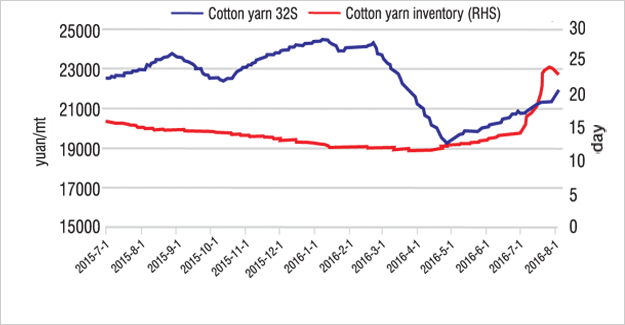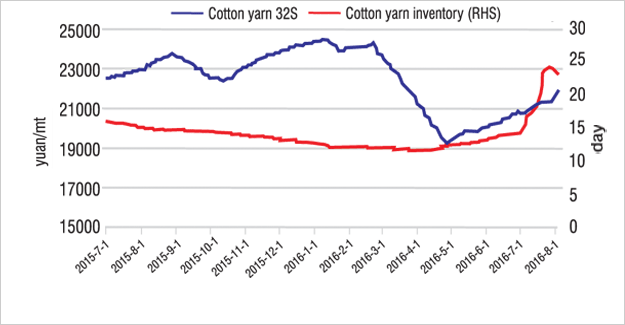
Impact Of China's Cotton Auction Extension
Firstly, on futures market, two long black lines and large quantity of long position liquidation indicate the short-term attitude of capital. Previously, the key factor was the inadequate supply of reserved cotton auction, but now, as the auction is prolonged, the supply will ease, so the whole industrial chain loses upward momentum, and the cotton futures on Zhengzhou Commodity Exchange was the first to respond. As the price gap between futures and spot cotton narrows, traders will begin to cut prices to sell, and spot cotton prices are expected to move lower.
As spot cotton prices fall, traders will be less interested to auction reserved cotton, leading to lower trading volumes of reserved cotton and trading prices. The cotton supply for textile mills is expected to increase later. Cotton yarn prices also tick down and cotton yarn inventory climbs up. The weaker sentiment also passes on to downstream fabric market. The pessimistic mood intensifies in the whole market. Some players look bearish towards the cotton futures, lower to 13,700 or 13,200 yuan/mt. In the international cotton market, cotton prices remain firm, supported by the tight supply.
Currently, Pakistani new cotton has begun to arrive in the market, but the quantity is small, and Brazilian cotton output is only projected at 1.35 million tons. Australian cotton output is less than 0.50 million tons and the cotton has been basically sold out at present. US, Indian, Uzbekistani, West African and Turkish cotton will be intensively arriving in November or after November. So actually, international cotton supply remains tight before November.
But for China, state cotton auction can refill the demand, so imported cotton yarn prices continue to be higher than Chinese cotton yarn since the second quarter of 2016. With the tight cotton supply before November, spinners will not be able to get ample cotton. Currently, imported cotton yarn inventory at major China ports scores at less than 70 kt and the monthly imports are around 150-170 kt, down from last year's 200 kt. With less import volumes and higher prices, Chinese cotton yarn prices are not likely to see continual decrease.
Looking from the cotton yarn costs calculated by cotton futures, the Chinese cotton yarn costs are lower than Vietnamese cotton yarn (the tariff is zero). Actually, if the procurement price of reserved cotton is 14,000 yuan/mt, the production costs of cotton yarn are around 20920-21200 yuan/mt. And for imported cotton yarn, the ordering costs are mainly around 22500 yuan/mt. The price edge of Chinese cotton yarn is obvious.
For ZCE cotton futures market, after sharp decrease and the consumption of the bearish news of state cotton auction extension, the market may rebound somewhat in the short run.

Textile Excellence
If you wish to Subscribe to Textile Excellence Print Edition, kindly fill in the below form and we shall get back to you with details.








